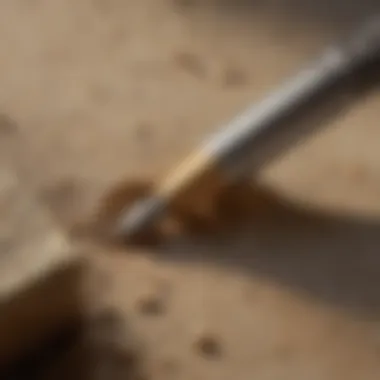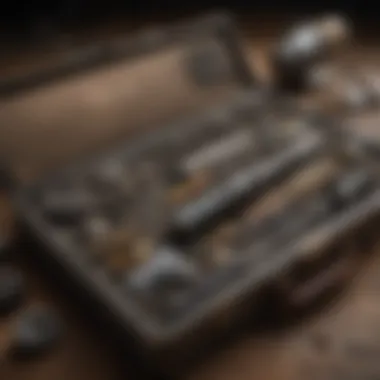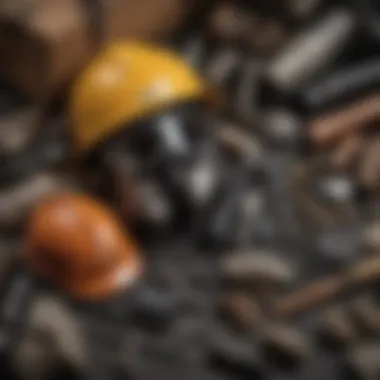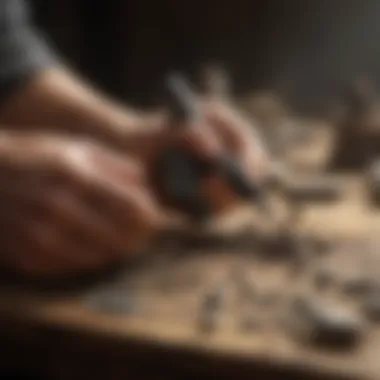Unlocking the Potential of Dremel Tools for Rock and Fossil Collectors


Rock and Fossil Identification
In the fascinating world of rock and fossil collecting, identification is a crucial skill that every enthusiast must master. Various types of rocks and fossils exist, each with distinct characteristics that set them apart. Rock collectors often look for specimens like igneous, sedimentary, and metamorphic rocks, while fossil enthusiasts may seek out fossils such as trilobites, ammonites, or plant imprints. Understanding the key characteristics to look for in these rocks and fossils is essential in distinguishing one type from another. When it comes to tools for identification, a Dremel tool becomes invaluable. Its precision and versatility enable collectors to carefully examine and reveal the details of each specimen with ease.
Collecting Tips and Techniques
Delving into the realm of rock and fossil collection requires not only a passion for discovery but also a set of best practices to ensure a fruitful experience. Seasoned collectors often emphasize the importance of researching and locating prime collecting sites. These sites are where treasures lie waiting to be unearthed, whether it be a shiny mineral or a perfectly preserved fossil. When it comes to safely extracting specimens, patience and gentle handling are key. Utilizing tools like brushes for delicate cleaning and chisels for careful extraction can help collectors safely retrieve their finds without causing any damage.
Preservation and Display
Once the thrill of collecting subsides, the task of preserving and displaying these precious rocks and fossils begins. Techniques like using stabilizing solutions for fragile rocks and creating protective encasements for delicate fossils can prolong their lifespan. Proper storage methods play a pivotal role in maintaining the integrity of collected specimens. Investing in acid-free storage containers and protective padding ensures that each rock and fossil remains intact for years to come. Creative display ideas, such as shadow boxes or themed showcases, add a personal touch to showcasing one's collection, making it not only a visual spectacle but also a story of discovery and admiration.
Geological Insights
Beyond the surface beauty of rocks and fossils lie geological insights that offer a glimpse into the Earth's history. Understanding geological formations and processes can shed light on how these specimens came to be. Exploring the historical significance of rocks and fossils reveals tales of ancient landscapes, forgotten species, and past climates. Delving into notable discoveries in the field provides a window into the groundbreaking findings that have shaped our understanding of the Earth's past. By immersing oneself in these geological insights, rock and fossil collectors gain a deeper appreciation for the treasures they hold in their hands.
Introduction
Dremel tools have become indispensable instruments for rock and fossil collectors, revolutionizing the way enthusiasts approach their craft. In this comprehensive guide, we will delve into the vital role that Dremel tools play in enhancing precision, versatility, and efficiency in rock and fossil collection. From exploring the nuances of these tools to unveiling maintenance tips and safety measures, this article aims to equip collectors with the knowledge necessary to elevate their collecting experience to new heights.
The Significance of Dremel Tools in Rock and Fossil Collection
Exploring the Versatility of Dremel Tools
The versatility of Dremel tools stands out as a hallmark feature that resonates deeply with rock and fossil collectors. These tools offer a diverse range of functionalities, from grinding to polishing, catering to the intricate needs of collectors. With the ability to switch between various attachments seamlessly, Dremel tools provide unparalleled adaptability in tackling different materials and textures. This adaptability ensures that collectors can approach a wide array of specimens with precision and finesse, enhancing the overall quality of their work.
Enhancing Precision and Detail Work


Precision and attention to detail are paramount in the realm of rock and fossil collection, where accuracy can determine the success of a project. Dremel tools excel in enhancing precision work, allowing collectors to carve intricate patterns, shape delicate fossils, and engrave with unmatched accuracy. The ergonomic design of these tools enables collectors to maneuver through detailed tasks with ease, showcasing a level of craftsmanship that elevates the final aesthetic appeal of their creations.
Overview of Dremel Tools
Understanding the Components
A fundamental aspect of utilizing Dremel tools efficiently lies in understanding their intricate components. From the motor to the chuck and the variable speed dial, each part plays a crucial role in ensuring smooth operation and optimal performance. By comprehending the synergy between these components, collectors can harness the full potential of their Dremel tools, maximizing output quality and efficiency in their projects.
Types of Dremel Tools
Dremel tools come in a diverse range of types, each tailored to serve specific functions within the realm of rock and fossil collection. Whether it's rotary tools, oscillating tools, or multi-tools, each type offers unique advantages that cater to varying project requirements. The versatility of these tools' designs ensures that collectors can select the most suitable option for their specific needs, thereby enhancing workflow efficiency and overall project quality.
Choosing the Right Dremel Tool
When delving into the world of rock and fossil collection, selecting the appropriate Dremel tool is paramount for enthusiasts. The choice of Dremel tool can significantly impact the efficiency and precision of the work involved, making it a critical decision in the collecting process. Understanding the specific criteria for selecting the right Dremel tool is essential to maximize its utility and benefits within this specialized field.
Factors to Consider
Speed Settings
Speed settings on Dremel tools play a crucial role in rock and fossil preparation. With the ability to adjust the speed of the tool, users can tailor the cutting, grinding, or polishing process to suit different types of rocks and fossils. The versatility of speed settings allows for intricate work on delicate fossils as well as more aggressive shaping on harder rocks. This flexibility in speed control enhances the precision and detail work required in rock and fossil collection, making it a popular choice among collectors.
Attachments and Accessories
Attachments and accessories for Dremel tools contribute significantly to their functionality and adaptability. The availability of a wide range of attachments, such as grinding stones, cutting discs, and polishing pads, allows collectors to perform various tasks with a single tool. These accessories expand the capabilities of the Dremel tool, making it a versatile and essential instrument in rock and fossil preparation. While the diverse range of attachments can enhance the tool's performance, users need to assess the advantages and disadvantages of each attachment to optimize their collecting experience.
Comfort and Ergonomics


Comfort and ergonomics are vital considerations when choosing a Dremel tool for rock and fossil collection. The design of the tool, including its grip, weight distribution, and handle shape, can impact the user's experience during prolonged use. Ergonomically designed Dremel tools reduce fatigue and strain on the hands and wrists, enabling collectors to work for extended periods comfortably. A comfortable grip and well-balanced tool contribute to precise and controlled movements, crucial for intricate tasks in rock and fossil preparation. Evaluating the comfort and ergonomics of a Dremel tool is essential for ensuring a seamless and efficient collecting process.
Utilizing Dremel Tools in Rock and Fossil Preparation
In the realm of rock and fossil collection, the utilization of Dremel tools plays a paramount role in enhancing precision and detail work. These tools are indispensable for enthusiasts looking to elevate their craftsmanship and skills to the next level. By leveraging Dremel tools effectively, collectors can achieve intricate patterns, delicately shape rocks, and bring out the fine details of fossils with utmost accuracy and finesse.
Exploring the Techniques for Precision Work
Grinding and Shaping
The technique of grinding and shaping using Dremel tools is a crucial aspect of rock and fossil preparation. With its abrasive power and versatility, grinding and shaping allow collectors to sculpt rocks and fossils to desired forms. The key characteristic of this technique lies in its ability to precisely remove material, making it an ideal choice for refining rough surfaces and achieving specific shapes. Its unique feature of adjustable speed settings enables users to control the intensity of grinding, ensuring accuracy and efficiency in the process. While grinding and shaping offer excellent precision, one should be mindful of potential dust exposure and the need for proper ventilation while working with these tools.
Polishing and Buffing
Polishing and buffing are essential techniques for rock and fossil collectors to bring out the natural luster and sheen of their specimens. These processes involve using polishing accessories and compounds with the Dremel tool to smoothen surfaces and enhance the visual appeal of rocks and fossils. The key characteristic of polishing and buffing lies in their ability to create a glossy finish, highlighting the intricate patterns and colors of the specimens. With minimal pressure and consistent circular motions, collectors can achieve professional-grade polishing results. However, it is important to note that excessive polishing may lead to overheating and potential damage to delicate fossils, requiring proper technique and care.
Engraving and Detailing
Engraving and detailing with Dremel tools enable collectors to add artistic flair and intricate designs to their rocks and fossils. This technique allows for precise incisions, fine lines, and detailed patterns, enhancing the overall aesthetics of the specimens. The key characteristic of engraving and detailing is the controlled depth and accuracy that can be achieved, making it a popular choice for creating personalized markings or intricate carvings. The unique feature of various engraving accessories further enhances the versatility of Dremel tools in this aspect. While engraving and detailing offer immense creative possibilities, collectors should practice on spare materials to master the level of control and depth desired for their final pieces.
Safety Measures and Best Practices
Prioritizing safety measures and best practices is paramount when utilizing Dremel tools in rock and fossil preparation to ensure a secure and productive working environment. By implementing protective gear and establishing an efficient workshop setup, collectors can safeguard themselves against potential hazards and optimize their crafting process.
Exploring Protective Gear
Protective Gear


The usage of protective gear, such as safety goggles, dust masks, and gloves, is essential to shield collectors from airborne particles and prevent injuries during rock and fossil preparation. The key characteristic of protective gear is its ability to minimize exposure to dust, debris, and potential splinters, ensuring the safety and well-being of individuals. By wearing appropriate protective gear, collectors can focus on their craft with peace of mind, knowing that they are mitigating risks and maintaining their health. However, prolonged use of protective gear may cause discomfort or hinder dexterity, requiring periodic breaks and adjustments for optimal performance.
Workshop Setup
Establishing an ergonomic and well-organized workshop setup is crucial for enhancing efficiency and safety in rock and fossil preparation activities. The key characteristic of a well-planned workshop setup lies in its functionality and accessibility of tools and materials, promoting a seamless workflow and minimizing unnecessary movements. By designating specific areas for cutting, grinding, and polishing, collectors can streamline their processes and reduce the risk of accidents or misplaced equipment. The unique feature of a workshop setup tailored to individual needs ensures personalized comfort and convenience, optimizing the overall rock and fossil preparation experience. While a well-equipped workshop enhances productivity, collectors should regularly assess and adapt their setup to accommodate evolving project requirements and safety considerations.
Maintaining and Caring for Dremel Tools
Maintaining and caring for Dremel tools is a critical aspect that cannot be overlooked in the realm of rock and fossil collecting. These indispensable tools require proper care to ensure longevity, optimal performance, and safe usage. By understanding the essential components of maintenance, enthusiasts can prolong the life of their Dremel tools while enhancing efficiency in their tasks.
Cleaning and Lubrication
Cleaning and lubrication stand as fundamental practices in preserving the functionality and durability of Dremel tools. This section focuses on the meticulous care required to keep these tools in prime condition, highlighting two crucial facets: preventative maintenance tips and storage recommendations.
Preventative Maintenance Tips
Preventative maintenance tips play a pivotal role in safeguarding the performance of Dremel tools. By adhering to regular maintenance schedules and practices, users can prevent wear and tear, extend the lifespan of their tools, and ensure consistent output. These tips involve cleaning the tool after each use, checking for loose components, and applying lubrication to moving parts. Emphasizing preventative maintenance fosters reliability and precision, essential traits for rock and fossil collectors relying on Dremel tools for intricate tasks.
Storage Recommendations
Effective storage of Dremel tools is key to maintaining their quality and functionality over time. Proper storage conditions shield the tools from dust, moisture, and external elements that could compromise their effectiveness. Storing Dremel tools in a dry, cool environment, away from direct sunlight and humidity, helps prevent corrosion and damage. Additionally, using protective cases or designated storage boxes keeps the tools organized and minimizes the risk of accidental mishandling or misplacement.
Conclusion
In the realm of rock and fossil collecting, the mastery of Dremel tools plays a pivotal role in elevating enthusiasts' experiences. This article has meticulously outlined the significance of efficient tool utilization and maintenance. As rock and fossil collectors delve deeper into their passion, the Conclusion section serves as a guiding beacon towards honing their craft. It encapsulates the essence of embracing creativity and precision while emphasizing the importance of continuous learning and improvement.
Mastering the Art of Dremel Tools
Embracing Creativity and Precision
Embracing creativity and precision within the context of Dremel tools is akin to unlocking a realm of infinite possibilities. The fusion of imagination and meticulous attention to detail allows collectors to transcend ordinary boundaries. The key characteristic of this approach lies in the seamless blend of artistic vision with technical execution, resulting in masterpieces that truly capture the essence of rock and fossil specimens. This intentional focus on precision ensures that every cut, polish, or engraving is executed with finesse, enhancing the overall quality of the final product. While the process demands patience and dedication, the reward of witnessing one's creative vision materialize into tangible form is unparalleled. The unique feature of embracing creativity and precision is its ability to transform mundane rocks or fossils into exquisite works of art, adding a personalized touch to each collection piece. The advantages of this approach are manifold, with enhanced aesthetic appeal, increased value, and a profound sense of accomplishment awaiting those who ardently embrace creativity and precision.
Continuous Learning and Improvement
The journey of rock and fossil collection is an ever-evolving process, requiring enthusiasts to embrace continuous learning and improvement. This facet underscores the essence of growth and development within the realm of Dremel tool usage. The key characteristic of this approach is the unending quest for knowledge and refinement in technique. By consistently seeking new methods, experimenting with different tools, and incorporating feedback, collectors can elevate their craft to new heights. The perpetual cycle of learning ensures that stagnation is not an option, pushing individuals to strive for excellence with each project undertaken. The unique feature of continuous learning and improvement is its transformative effect on collectors, enabling them to adapt to new challenges, innovate in their approaches, and refine their skill set over time. While the path may be arduous at times, the rewards of constant growth include mastery of technique, increased proficiency, and a distinguished reputation within the collecting community. Embracing this philosophy paves the way for a fulfilling and enriching journey in the world of Dremel tools for rock and fossil collectors.







